Lakeshore EMPX-H2 Cryogenic Probe Station Installation guide
- Type
- Installation guide
This manual is also suitable for
- CPX Cryogenic Probe Station
- CPX-VF Cryogenic Probe Station
- CRX-4K Cryogenic Probe Station
- CRX-6.5K Cryogenic Probe Station
- CRX-EM-HF Cryogenic Probe Station
- CRX-VF Cryogenic Probe Station
- EMPX-HF Cryogenic Probe Station
- FWPX Cryogenic Probe Station
- PS-100 Tabletop Probe Station
- TTPX Cryogenic Probe Station

Lake Shore Cryotronics, Inc. ▪ F099-12-00_C ▪ info@lakeshore.com ▪ www.lakeshore.com
ZN50R-CVT Probe
Operating Instructions
Introduction
Lake Shore’s patented Model ZN50R-CVT (continuously variable
temperature) probes enable uninterrupted or unattended variable
temperature measurements in the Lake Shore probe stations. The
probe’s integrated flexible member compensates for thermal
expansion in the probe arm that occurs during normal operation
when the sample stage temperature is changed. The probe keeps
its tip at a fixed landing location.
The ZN50R-CVT probes are interchangeable with standard ZN50R
probes, and are compatible with standard ZN50 probe mounts and
cable options.
Removing the probe from the case
Carefully remove the ZN50R-CVT probe from its
protective case by grasping the gold SMA connector
and gently pulling the probe out of the foam. It may be
necessary to rotate the probe back and forth to free
the probe from the foam. Be careful not to grasp the
silver colored spring member of the probe body as this
member is flexible and is easily damaged. Damage to
the flexible spring member will affect probe
performance. Anytime the probe is removed from the
probe station it should be returned to the storage case
for protection.
CAUTION: Grasping the flexible spring member may
cause permanent damage to the ZN50R-CVT probe

Lake Shore Cryotronics, Inc. ▪ F099-12-00_C ▪ info@lakeshore.com ▪ www.lakeshore.com
Installation
The procedure for installing a ZN50R-CVT probe is the same
as for the standard ZN50R probe. Follow the steps in the
section titled Installing a ZN50R Probe in Chapter 3 of the
probe station manual. The ZN50R-CVT probe should be
placed in the holder with the ceramic blade fully inserted into
the probe holder and with the bottom of the ceramic blade
flush with the bottom of the probe holder as shown in the
photo.
When properly installed, the probe will be straight in the
holder, and there will be approximately a 1 mm gap between
the front of the probe holder and the ZN50R-CVT flexible
spring member. This gap is necessary to ensure that the
member does not contact the probe holder. If the spring
member contacts the probe holder during variable temperature
operation, the signal tip for that probe will be electrically
shorted to ground.
ZN50R-CVT probe shown properly mounted in probe holder.
Ensure there is approximately 1 mm gap between the spring and probe holder.
Operation
Landing the ZN50R-CVT probe tip on the sample surface is different than standard ZN50R probes. Standard
probe tips have a tendency to “skate” across the surface of the sample when making contact. The ZN50R-CVT
probe does not skate. The spring member will instead flex. Users should watch for this flexing movement when
beginning to make contact. Too much downward Z-travel after making contact can result in too much force on the
probe tip and cause damage. However, too little downward Z-travel can result in too little force exerted reducing
the variable temperature performance. Too little force can also cause poor or inconsistent electrical contact. The
proper landing procedure must be followed to ensure the rated performance and consistent measurement results.
1 mm

Lake Shore Cryotronics, Inc. ▪ F099-12-00_C ▪ info@lakeshore.com ▪ www.lakeshore.com
Landing Procedure
The following probe station procedure should be followed for landing the ZN50R-CVT probes. This procedure
assumes the probes are installed in the station with the probes a few millimeters above the sample.
1. Use the camera to zoom and focus on the landing pad or area.
2. Use the z-axis micrometer to lower the probe. When the tip makes contact with the landing pad, the spring
member and tip assembly will move in the negative X direction while lowering in the z-axis direction. The tip
may also begin to bend or flex (see picture below).
3. Note the z-axis micrometer reading at the point of first contact of the tip to the sample. Stable contact
between the tip and sample can be made with additional, downward z-axis over-travel past the point of
contact.
4. Refer to Table 1 for the recommended amount of probe tip over-travel for each probe station model. The
over-travel required is dependent on probe station model. One full turn of the z-axis micrometer is
represented by 50 tick marks and is equal to 500 m.
5. Depending on the sample type and landing pad material, you may need to adjust the landing procedure for
best ZN50R-CVT performance.
Left: ZN50R-CVT probe tip makes contact with gold pad; Right: BeCu probe is over-traveled. Notice
the entire probe moves left (negative x-direction) and the tip bends. This exposes more of the top of the
probe tip to the camera.
CAUTION: Too much over-travel in the z-axis direction can result in damage to the tip or the sample.
CPX, CPX-VF, CPX-HF
CRX-VF
TTPX, EMPX-HF, FWPX
CRX-6.5K, CRX-4K, CRX-EM-HF
Downward over
travel on landing
75 to 100 m
(7.5 to 10 tick marks on z-axis micrometer)
150 to 200 m
(15 to 20 tick marks on z-axis micrometer)
Table 1. ZN50R-CVT over-travel for each probe station model

Lake Shore Cryotronics, Inc. ▪ F099-12-00_C ▪ info@lakeshore.com ▪ www.lakeshore.com
Temperature Operation
The operational temperature range for the ZN50R-CVT probe is defined as starting at the lowest desired
temperature and warming the sample stage through the range. The starting temperature may be anywhere in the
probe station’s sample stage operating limits. The ZN50R-CVT probe’s ability to keep the tip stable while landed on
a sample is dependent on both the probe tip (material and radius) and on the probe station model. Composition of
the landing pad is also critical to the probe performance. Table 2 gives the temperature range specifications for the
ZN50R-CVT probes for each probe station model when landed on gold plated copper pads. Harder or softer pads
may affect temperature range.
CPX, CPX-VF, CPX-HF
CRX-VF
TTPX, EMPX-HF, FWPX
CRX-6.5K, CRX-4K, CRX-EM-HF
ZN50R-CVT-25-W
400 K
150 K
ZN50R-CVT-10-W
200 K
100 K
ZN50R-CVT-25-BECU
200 K
100 K
Table 2. ZN50R-CVT temperature range for each probe station model
The following probe station procedure should be followed for making variable temperature measurements using
the ZN50R-CVT probes. This procedure assumes the probes are installed and the station has been prepared for
standard temperature operation using the procedures in the probe station manual.
1. Use the z-axis micrometers to raise all probes 3 mm to 4 mm above the sample. Failure to do so will
potentially cause damage to the probe tip or scratch the sample surface.
2. Cool the entire probe station to base temperature allowing the probe arms and radiation shields to stabilize in
temperature prior to beginning a measurement.
3. Once the station is stabilized at base temperature, control the sample stage to the desired starting
temperature for the measurement.
4. Land the probe tips using the specified amount of probe tip over-travel from Table 1 above.
5. Control the sample stage over the allowable temperature range given in Table 2. The Setpoint ramping
feature of the Model 336 is recommended.
6. Once the temperature range is completed, the sample stage may be cooled back to the starting temperature
with the probe tip landed, or the probe tip can be raised and re-landed to control the sample stage through
another temperature range up in temperature.
CAUTION: When the ZN50R-CVT probe is raised at the warm end of a variable temperature run the tip may
have a tendency to spring forward as the probe is raised. This spring action may cause damage to delicate
sample landing pads. To avoid this, while raising the probes also retract the probe in the negative x-axis
direction by approximately 100 to 200 m to unload the spring tension in the flexible member.
-
 1
1
-
 2
2
-
 3
3
-
 4
4
Lakeshore EMPX-H2 Cryogenic Probe Station Installation guide
- Type
- Installation guide
- This manual is also suitable for
-
- CPX Cryogenic Probe Station
- CPX-VF Cryogenic Probe Station
- CRX-4K Cryogenic Probe Station
- CRX-6.5K Cryogenic Probe Station
- CRX-EM-HF Cryogenic Probe Station
- CRX-VF Cryogenic Probe Station
- EMPX-HF Cryogenic Probe Station
- FWPX Cryogenic Probe Station
- PS-100 Tabletop Probe Station
- TTPX Cryogenic Probe Station
Ask a question and I''ll find the answer in the document
Finding information in a document is now easier with AI
Related papers
-
 Lakeshore FWP6 Owner's manual
Lakeshore FWP6 Owner's manual
-
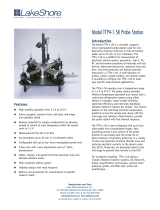 Lakeshore TTP4-1.5K Owner's manual
Lakeshore TTP4-1.5K Owner's manual
-
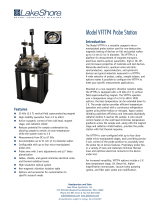 Lakeshore VFTTP4 Owner's manual
Lakeshore VFTTP4 Owner's manual
-
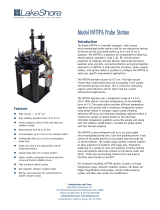 Lakeshore HVTTP6 Owner's manual
Lakeshore HVTTP6 Owner's manual
-
 Lakeshore TTP6 Owner's manual
Lakeshore TTP6 Owner's manual
-
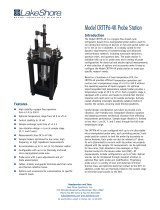 Lakeshore CRTTP6-4K Owner's manual
Lakeshore CRTTP6-4K Owner's manual
-
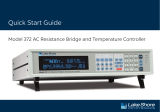 Lakeshore 372 AC Resistance Bridge Quick start guide
Lakeshore 372 AC Resistance Bridge Quick start guide
-
 Lakeshore M81-SSM Synchronous Source Measure System User guide
Lakeshore M81-SSM Synchronous Source Measure System User guide
-
 Lakeshore M91 FastHall™ Measurement Controller Quick start guide
Lakeshore M91 FastHall™ Measurement Controller Quick start guide
-
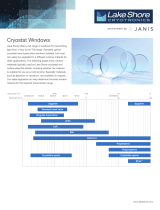 Lakeshore CCR UHV cryostats User guide
Lakeshore CCR UHV cryostats User guide
Other documents
-
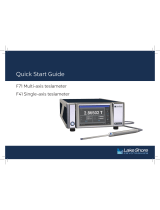 Lake Shore F71 Quick start guide
Lake Shore F71 Quick start guide
-
Suzuki AN 650 Burgman K3 Owner's manual
-
BOMBARDIER RALLY 200 2003 Shop Manual
-
Suzuki LT-Z50 User manual
-
TGB EST 1000 User manual
-
APRILIA scarabeo 200 i.e. Service Station Manual
-
Suzuki AN650/A Supplementary Service Manual
-
Wolf DF60 User manual
-
Yard Machines 13AR791G790 Specification
-
Wolf DO30U/B User manual














